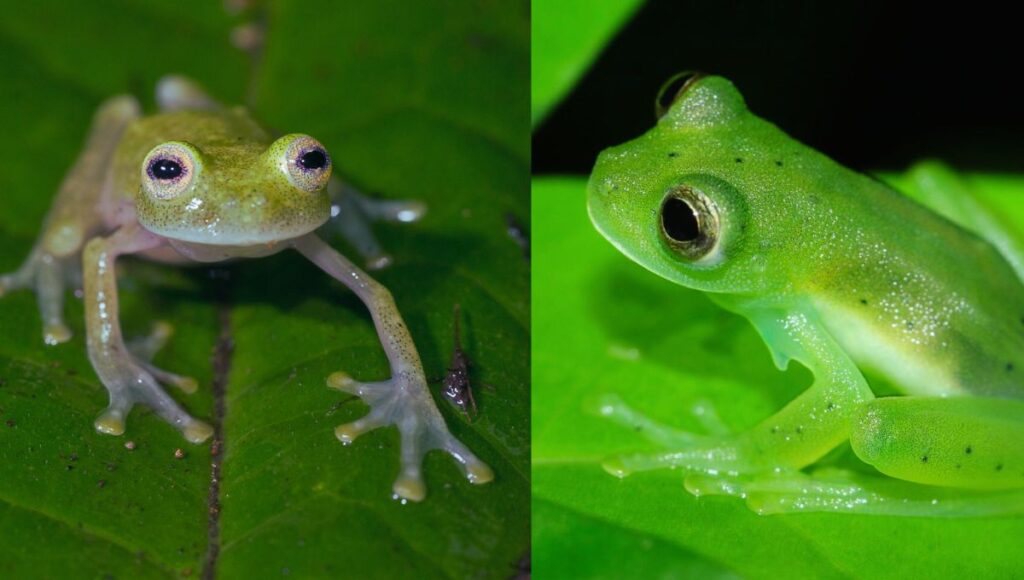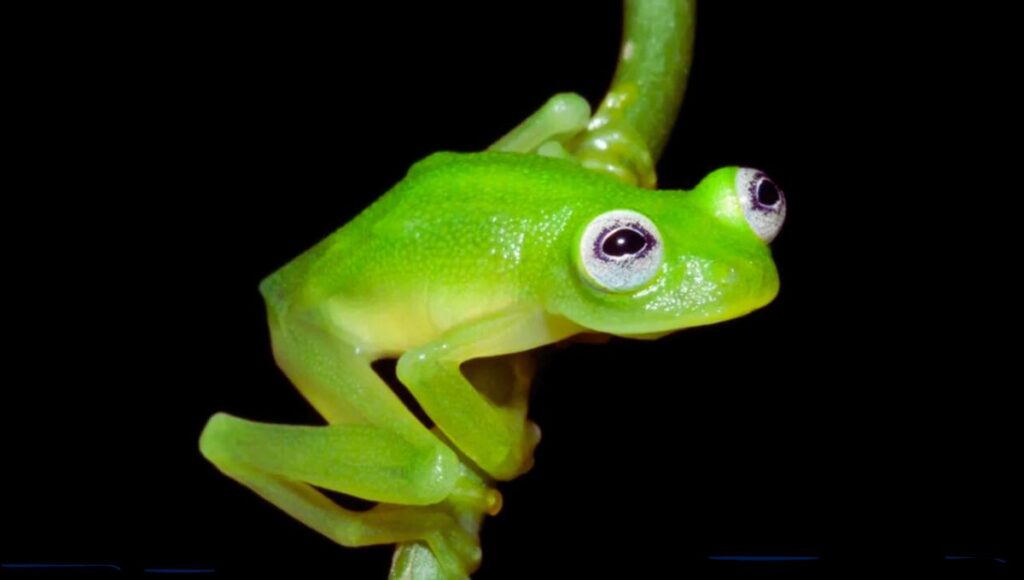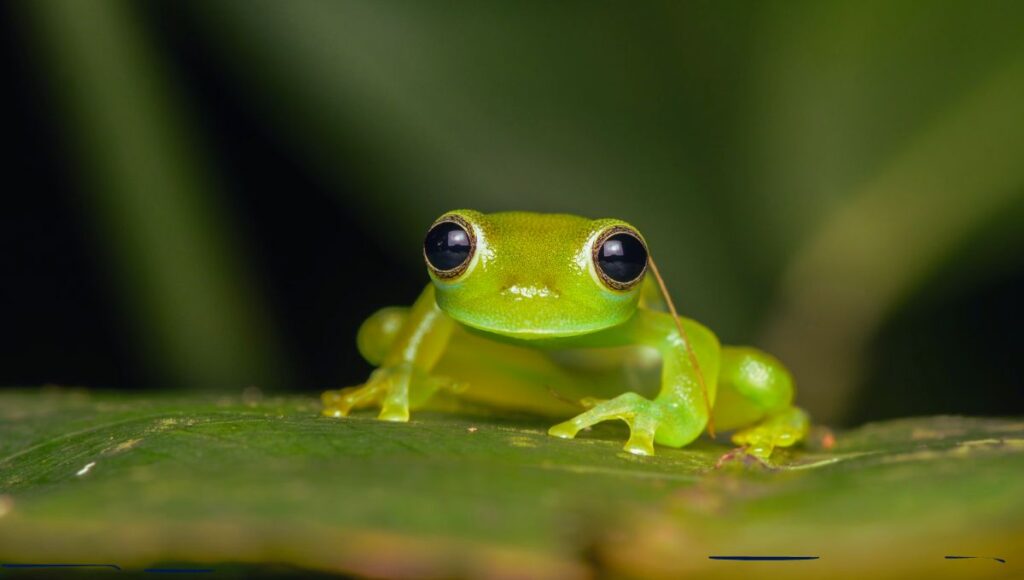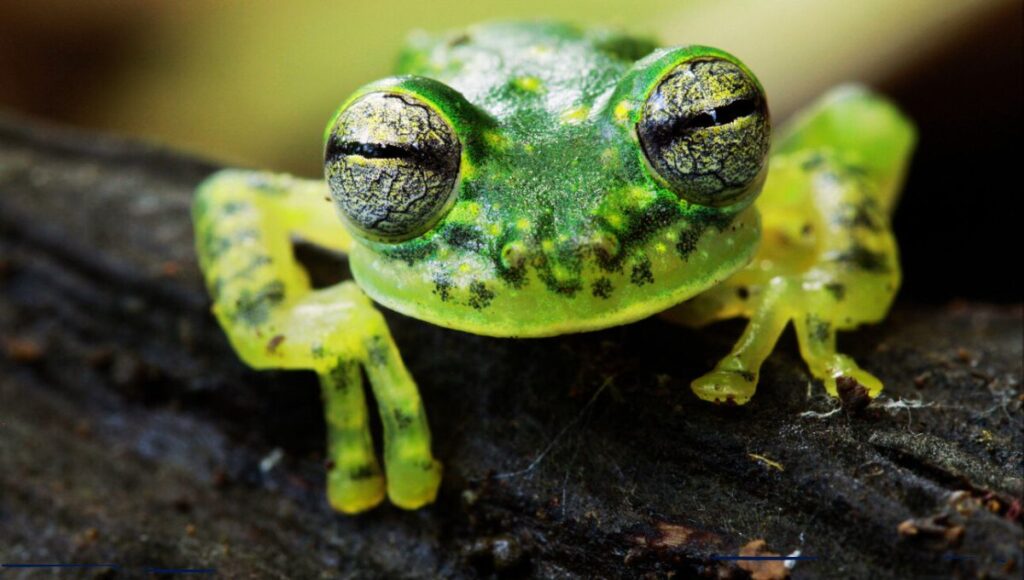Glass frogs are charming and exotic frog species that derived their name from their transparent and translucent skin. The frog species is generally arboreal and tends to live in forests. But are glass frogs good pets or should you avoid them as a beginner?

Table of Contents
Everything about Glass Frogs:
In a Glimpse:
| Common Name | Glass Frogs |
| Scientific Name | Centrolenidae |
| Other Names | N/A |
| Maximum Length | 3 inches |
| Maximum Weight | 15 grams |
| Ranges | Central and South America |
| Habitat | Warm and Moist dense forest |
| Diet | Carnivore |
| IUCN Status | Endangered |
| Lifespan | 10-14 years |
Origin:
Glass frogs are very widespread, especially in South America. The frogs are found in Mexico to Panama including Bolivia, Venezuela, Costa Rica, the Amazon and Orinoco River basins, the Guiana Shield region, Brazil, and Argentina.
Habitat:
The frogs are arboreal and live in trees and leaves. They usually prefer moist and dense tropical forests and montane cloud forests to live in. They are habituated to sleep in the trees’ leaves and are sometimes found in the lowlands. They prefer forests closer to streams or rivers.
Physical Characteristics: How do you identify a Glass Frog?

Glass frogs are small in size ranging from 1.2 in- 3 in or 3-7.5 cm and their body is mostly green except for the lower body which is transparent and translucent. The transparent skin allows one to look into internal organs and viscera including the heart, liver, and gastrointestinal tract. The small frog species weighs around 6-15 grams. They have big, golden-green eyes that face forward from the top of their heads and rotate independently. Their eyesight is very sharp and helps them to hunt.
Colours:
The frogs are usually lime green in colour with transparent and translucent on the back and chest. Transparent skin allows them to blend with the surroundings and show camouflage. Some types of glass frogs also have white and yellow spots that mimic their eggs.
Camouflage:
Glass frogs show camouflage as a part of their defence mechanism. It was found that their skin changed colour very little against darker or lighter foliage but their legs were more translucent and consequently changed in brightness. The frogs show edge diffusion in which their edges are softened to match the relative brightness of their surroundings.
It was found in 2022 that these frogs can conceal red blood cells inside their liver which helps to increase transparency when they are vulnerable. While in most animals, this process can cause massive clotting, Glass frogs are skilled enough to regulate the location, density, and packing of red cells without clotting. Camouflage plays the biggest part in their defence mechanism and due to low visibility, they are less prone to attack by prey birds.
Are Glass frogs poisonous?

The frog species is not poisonous. They don’t possess any toxins that could harm humans or animals. They are considered one of the safest frogs for pets if you can properly care for them. The frogs are not also aggressive, they can peacefully co-exist with other glass frogs or similar-sized amphibians.
Lifespan:
The frogs can live up to 10 – 14 years in the wild but in captivity, with proper care, they are expected to live much longer.
Diet:
Glass frogs are carnivores and eat small insects such as ants, moths, spiders, crickets, bugs, and flies. Sometimes, they also consume other smaller tree frogs. The frogs usually stay still on the branches of trees and wait for their prey. When the prey is in their reach, they attack them with their tongue to gobble the insect up.
Predators:
Snakes, lizards, prey birds, and other mammals are their predators. The main predator the the frog in the tadpole stage are frog flies which lay their eggs within the frog’s eggs and after hatching the maggots consume the embryos of the glass frogs.
Other Threats:

The frog species face other kinds of anthropogenic threats as well apart from its natural predators. Expansion of agriculture, human settlement in that area, mining, and other kind of human activities led to fragmentation of their natural habitats. Climate change also results in hotter and drier climates which ultimately decreases moisture which is essential for their survival. Glass frogs are also victims of poaching and trafficking due to their mesmarizing appearance and demand in the market.
Conservation Status:
The number of Glass frogs is unknown but it is estimated that up to 36 subspecies of the frog are endangered. In Costa Rica, there was a movement to save the species by protecting their natural habitat in 2022 which was supported by countries like Brazil and Argentina. The frog species is listed in Appendix II of CITES and most of the species of the frog are listed as “Endangered” in the IUCN Red List of Threatened Species.
Behavior:
The frogs are nocturnal and used to live in small groups. They hunt food from dusk to sunrise and with the sunrise they hide in the trees under the leaves in the upper canopy. The frogs usually sleep all day and again appear in the dark. In the summer or dry season, they usually live high up in the trees which is beyond the reach of any land-based predators. The frogs come down from the trees with the advent of rain.
Are Glass Frogs good as pets?

The lime-green frogs often compelled the pet lovers with their mesmerizing beauty and transparent skins. They are wild frogs and require a wild environment to survive. The exotic frog species cannot thrive without warm and wet environments and dense vegetation. However, a garden with many short trees inside the enclosure can solve the problem. The frogs consistently need clean water, live plants, high humidity, and plenty of insects and warms to live.
Most of the Glass frogs in the international pet trade come from captive breeding but due to their high demand in the market, some of the frogs are illegally captured from the wild. These activities hurt the population of the frogs. Hence, it is advised to buy the frogs from a reputed source that has been bred in captivity.
However, if you are ready to invest your time, energy, and money then these frogs can be very rewarding. As they are nocturnal and live in the upper canopy, you might not find them in the morning but at night they can be your partner. Due to their small size, they can be attacked by predators anytime. Thus it is very important to monitor the frogs as much as possible, especially in the morning.
Due to their wild nature, the frogs are not easy to pet or suitable for beginners or casual hobbyists. They are best suitable for experienced, responsible, and professional breeders who know how to care for and respect their personal space.
How do you buy a Glass frog?
The frogs are only found in Central and South America and are often found hidden in shipments of animals exported from Central America to Europe. These frogs are mostly captured illegally from the wild and are illegal in many countries in Europe. With the help of IFAW and other NGOs, restrictions on trade in glass frogs have been increased significantly.
Hence, it is advised to buy the endangered frog from a reputed breeder and confirm that the frog has been bred in captivity. You can also find the frog online but before buying check the reviews, policies, and laws relating to the species in your country. Don’t forget to ask for proof of origin and a health certificate from the breeder. Try not to buy any illegally traded frogs or it’ll encourage illegal poaching and that will harm the population of Glass frogs.
Requirements and Care:
Tanks:
The Glass frogs require a large vertical and well-ventilated tank that mimics their natural habitat. The rule of thumb states that the bigger the tank, the better for the frog. In case you lack space, you at least need a 20-gallon tank with a lid that allows air circulation and prevents escaping.
Substrate:
The frogs need a substrate that holds moisture for a long time and also prevents bacterial growth. You can use soil, peat moss, coco fibre, etc as a base layer along with some leaf litter, bark, or wood on top.
Plants:
Glass frogs need plenty of live or artificial plants to live, hide, and climb. You can use orchids, ferns, vines, and other tropical trees that can maintain high moisture levels. Ensure the plants are not toxic and free from pesticides.
Water:
The frogs need a constant supply of fresh water to drink and soak in. You may use a shallow water dish, a drip system, or a waterfall to provide fresh water. The water must be dechlorinated, filtered, and changed regularly.
Temperature and Humidity:
Glass frogs need a warm temperature (72-78 degrees Fahrenheit) to survive. You can use a heat lamp/mat to maintain a stable temperature. Use a thermometer to prevent the enclosure from overheating.
Also, the frogs need a high humidity level (80-90%) to thrive. You can use a humidifier or fogger or sprinkle water several times a day to maintain the humidity.
Lighting:
Like any other frogs, Glass frogs need a 12-hour light circle to regulate their daily activities. You can use a low-wattage fluorescent, LED or UVB blub to provide them with the required light.
Diet:
The frogs are carnivorous and feed on small insects such as ants, moths, spiders, crickets, bugs, and flies. You should dust their food with calcium and vitamin supplements at least once a week to provide them with proper nutrition. You can feed them every other day and is based on their age, size, activity level, and appetite.
Handling:
Like other wild frogs, Glass frogs don’t like much human interaction. Handling them can cause stress to them, damage their skin, or expose them to harmful bacteria or chemicals. Hence, it is advised not to touch them unless it is very necessary (such as cleaning or moving). You can use gloves or soft clothes to handle them and always wash your hands with soap before and after touching them.
Glass frogs are not suitable for beginners or casual hobbyists because there are many legal and ethical aspects associated with them. If you want to buy the frog, research first and consult a veterinary surgeon (who specializes in amphibians) for more advice and guidance.
FAQs:
Can Glass Frog jump?
Yes, it is an important part of their defence mechanism. If they face a threat, the frogs can jump more than 10 inches or 25 cm at a time.
Why are the frogs known as glass frogs?
The colour of the frogs is lime-green but their abdomen and chest are transparent and translucent. The internal viscera, heart, lungs, and gastrointestinal tract, can be seen from outside. Even they can increase or decrease the transparency by concealing red blood cells concentrated in their liver. As the frogs are transparent like glass, they are commonly known as Glass Frogs.
Reference: Wikipedia
Also Read: Are Pixie Frogs (African Bullfrogs) Good Pets? Everything You Should Know Before Purchasing